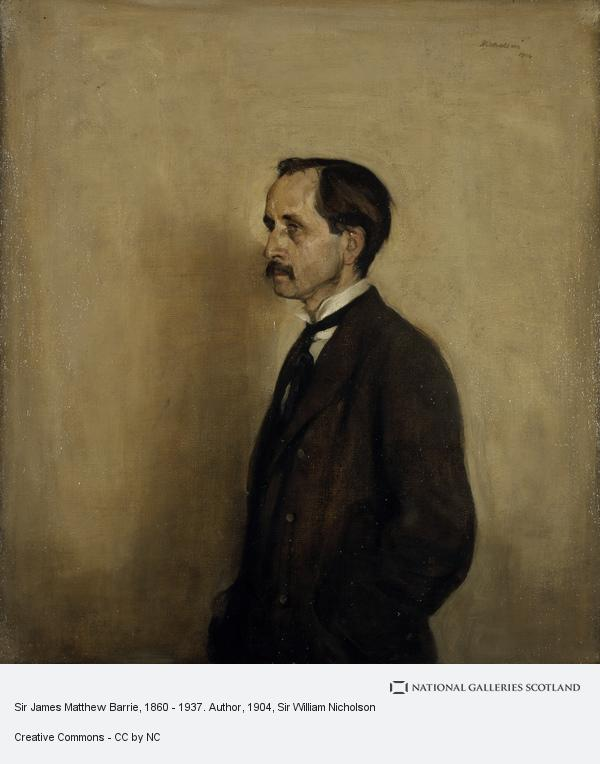
Portrait by Sir William Nicholson. Retrieved from National Galleries Scotland (accessed: January 13, 2022). Creative Commons CC BY-NC.
James Matthew Barrie
, 1860 - 1937
James Matthew Barrie was born on the 9th May 1860 in Kirriemuir, Scotland. He was the ninth of ten children, and the third son, born to David Barrie, a handloom weaver, and Margaret Ogilvy. His elder brother David died when James was six, and after his death, James endeavored to take his place in his mother’s affections. The events surely shaped the writer he was to become. He spent many hours beside his grieving mother, where they read such stories as Robinson Crusoe (1719) and the historical novels of Sir Walter Scott. He was drawn to adventure stories, and his mother also shared with him the story of her own youth. Margaret had taken over care of her household, including care of her younger brother, when she was just eight years old, because her mother had died. It is generally considered that the idea of a young Margaret keeping house came to influence Barrie’s creation of Wendy, and the memory of his dead brother, a boy forever suspended in time, came to inform the life of Peter Pan.
Barrie attended Dumfries Academy from the age of thirteen, and this is where he was first publicly acknowledged for his writing. Inspired by the adventure tales in penny dreadfuls (popular adventure stories), Barrie wrote Bandelero, The Bandit (1877), a short play for the drama society he created with a schoolmate. The play offended the morality of a minister, who admonished it in the local paper, but Barrie and his friends successfully sought support for the work from some distinguished members of theatre and from the London newspapers. He shortly thereafter began studying literature at Edinburgh University in 1878, and here he received his Master of Arts in 1882. During his time at Edinburgh University, he wrote for the Edinburgh Evening Courant as a freelance drama critic, and then, after graduation, early in 1883, he began working as a staff columnist for the Nottingham Journal. He then returned to Kirriemuir, where he wrote articles set in the town’s past for the St. James’s Gazette. Many of these were centred on a religious sect, the Auld Licht, of which his grandfather had been a member, and these articles came to earn him attention as an emerging writer. He continued to write them after moving to London, and a collection of them were published as Auld Licht Idylls (1888). This volume then became the first in a series of three works centred around the fictional town of Thrums: based on Kirriemuir. A Window in Thrums (1889), the second work, also consisted of articles previously published, but the third text was a novel entitled The Little Minister (1891). This novel was a welcome success for Barrie after the failure of his first, Better Dead (1888), which was self-published.
Around this time, while also working as a journalist, Barrie began writing plays. The first, Richard Savage (1891), he wrote with H.B Marriott Watson. It ran only once, but his next play Ibsen’s Ghost; or, Toole Up-to-Date (1891) was better received. He then met his future wife, actress Mary Ansell, while developing his play Walker, London (1892). They were married in 1894 but later divorced in 1909. Barrie became a very accomplished and prolific writer who went on to write many plays, short stories, novels, including a biography of his mother, and even two motion picture scripts. Barrie’s character of Peter Pan, however, first appeared in the novel The Little White Bird (1902), as the seven-day-old adventurer of Kensington Gardens. Those chapters featuring Peter Pan were later published in an illustrated volume named Peter Pan in Kensington Gardens (1906). After The Little White Bird, he next appeared in Barrie’s play Peter Pan, or The Boy Who Wouldn’t Grow up. The play premiered in 1904 but was not published until 1928, and, by then, he had written Peter and Wendy (1911). The text is commonly now known as Peter Pan, and it is undoubtedly Barrie’s most famous and enduring work. The character of Peter Pan was created to amuse the elder Llewelyn Davies boys, who were children of Barrie’s friends, when Peter, the middle child, was a baby. Barrie liked to tell them that their infant brother could, in fact, fly. He later adopted all five boys after the passing of their parents.
Barrie died in 1937, and he willed the rights to the novel Peter and Wendy, and the play, to the Great Ormond Street Hospital for Children.
Sources:
Brownson, Siobhan Craft, "J. M. Barrie (9 May 1860–19 June 1937)", in William F. Naufftus, ed., British Short-Fiction Writers, 1880–1914: The Romantic Tradition, 156.1 (1995): 14–24. Dictionary of Literary Biography Vol. 156. Gale Literature: Dictionary of Literary Biography;
Rudolph, Valerie C., "James M. Barrie (9 May 1860–19 June 1937)", in Stanley Weintraub, ed., Modern British Dramatists, 1900–1945, 10:1 (1982): 32–45. Dictionary of Literary Biography Vol. 10. Gale Literature: Dictionary of Literary Biography;
White, Donna R., "J. M. Barrie (9 May 1860–19 June 1937)", in Laura M. Zaidman, ed., British Children's Writers, 1880–1914, 141:1: (1994): 23–39. Dictionary of Literary Biography Vol. 141. Gale Literature: Dictionary of Literary Biography,
Bio prepared by Michelle Wyatt, University of New England, michellewyatt5@gmail.com
Records in database:


